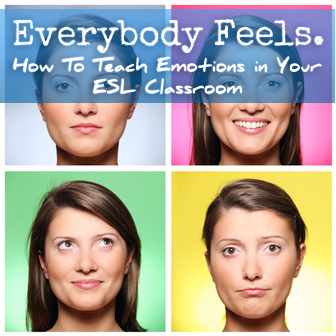Are You Feeling Blue? 4 Ways to Use Color to Teach Other Concepts in English


Bring emotions to a tactile level for your students with these concrete activities, and you’ll all feel better at the end of the day.
Start Thinking About Feeling
The first step in teaching about emotions is to engage your students. If you have younger students, picture books are a great way to do this. Some good ones to try are Today I Feel Silly: and Other Moods That Make My Day by Jamie Lee Curtis or I Feel Orange Today by Patricia Godwin. After reading these or other books that your class likes, encourage your students to share how they are feeling today. Make sure they know that any answer is a good one; the key is to be honest. Also, remember that younger children may not be as attuned to their feelings as more mature students can be, so keep from forcing an answer if all they can say is that they feel fine.
Another way to engage your students at the beginning of an emotional lesson is to sing some songs about feelings. “If You’re Happy and You Know It Clap Your Hands” is a great way to engage young children. The rhythm of the verses also helps with sentence intonation and pacing for students who struggle with their fluency. You could also sing “Who’s Afraid of the Big Bad Wolf” or any other songs they might know and love that mention any kind of emotion.
Take a Closer Look
Now that your class is thinking about emotions, it’s time to start some more structured work. Give a second use to old magazines by cutting out pictures of faces displaying different emotions. The bigger the face, the easier it will be for your students to see the emotion. Show one picture at a time during circle time or during a class discussion, and ask your students how they think that person is feeling. Ask them why they think the person is feeling that way. What are the clues they take from the person’s facial expression? Then have a little fun and ask your students to mimic the face from the picture to show that same emotion. Even better than magazine photos, take some candid pictures of your students prior to teaching on this topic and use the faces they make for the same activity. Kids will love seeing themselves larger than life in front of the class and will feel a deep connection to the lesson when you involve their personal photos.
Today I feel board. That’s not to say I feel bored. Maybe I feel happy, confused, concerned, elated, hysterical, nervous or loved. Our emotions change from day to day, so give your students a venue through which to share their emotions. Choose a selection of simple cartoon faces and print them out on full sheets of paper. (If you are nice to the art teacher at your school, he or she may draw you some original ones.) You can then post them on a bulletin board with a label under the picture naming that emotion. Then give each of your students a name tag with a push pin and ask them to place their name next to or under the emotion they are feeling today. (Be careful not to hang the faces too high for your students to reach.) This will give them some reading practice, but an even more beneficial activity is to ask your students to share why they feel a particular way on the day of the discussion. This promotes discussion and also gives your students an appropriate place and time to share special news. You can keep this bulletin board up all year if you choose to do so, and you can add more descriptive emotions as the year progresses thereby increasing your students’ vocabulary.
Write It Out
Remember those pictures of faces you used in your class discussion? Now it’s time to use them for a little writing practice. You will want to choose your writing activity based on the ages of your students. For younger students, give them one of the pictures you discussed earlier. Have them spend some time thinking about the emotion that person is feeling. Then ask them about a time they felt that same emotion. You can allow some time for class sharing or break your class into smaller groups so everyone can share their personal story. Then get in your writing practice by having students write about that time they had that particular emotions. This is especially good for younger children since it is easiest for them to share from their personal experiences. If your students are more mature, you can make the writing practice a little more challenging and a little more creative. Have them think beyond what the person in the picture is feeling and challenge them to think why the person feels that way. What could that person’s story be? When your students write, have them do some creative writing telling the story of the person in the picture. Encourage them to use detailed descriptions and strong verbs in their creative writing.
Either way, when you teach about emotions, your students are sure to feel excited, eager, thrilled, animated, energized, full of life, absorbed…